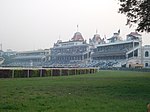Victoria Memorial, Kolkata
1921 establishments in India20th-century architecture in India20th century in KolkataArt museums and galleries in KolkataBuildings and structures completed in 1921 ... and 11 more
City museumsEngvarB from January 2014Gardens in IndiaIndo-Saracenic Revival architectureMarble buildingsMonuments and memorials in KolkataMonuments and memorials to Queen VictoriaMuseums established in 1921Museums in KolkataNational museums of IndiaTourist attractions in Kolkata

The Victoria Memorial is a large marble building on the Maidan in Central Kolkata, having its entrance on the Queen's Way. It was built between 1906 and 1921 by then British government. It is dedicated to the memory of Queen Victoria, Empress of India from 1876 to 1901. The largest monument to a monarch anywhere in the world, it stands in 64 acres of gardens and is now a museum under the control of the Ministry of Culture. Possessing prominent features of british architecture of colonial era, it has evolved into one of the most popular places in the city.
Excerpt from the Wikipedia article Victoria Memorial, Kolkata (License: CC BY-SA 3.0, Authors, Images).Victoria Memorial, Kolkata
Queen's Way, Kolkata Maidan (Kolkata District)
Geographical coordinates (GPS) Address Website External links Nearby Places Show on map
Geographical coordinates (GPS)
| Latitude | Longitude |
|---|---|
| N 22.5449 ° | E 88.3425 ° |
Address
ভিক্টোরিয়া মেমোরিয়াল হল
Queen's Way 1
700071 Kolkata, Maidan (Kolkata District)
West Bengal, India
Open on Google Maps








